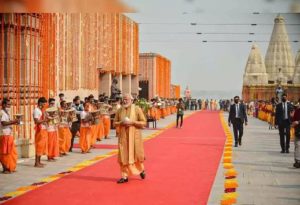
Prime Minister Narendra Modi visits Kashi Vishwanath Dham Temple in Varanasi. (Photo credit: PTI)
New Delhi: Kashi in the ancient age, Varanasi in the modern era. You can call the city by whichever name you like, the sense of awe and respect that it evokes will remain the same. Proudly standing on the banks of the River Ganges in Uttar Pradesh, Varanasi has a history entwined in each of its bricks. The name of Varanasi can be found even in the mythology of India, as it is said that Lord Shiva founded the city. Thus, Varanasi is not just another city in India, but it is a symbol of the cultural and religious amalgamation of the country. On Monday, Prime Minister Narendra Modi inaugurated the Kashi Vishwanath Corridor’s first phase.
History of Kashi or Varanasi: City of temples
If we go by Indian mythology, then Varanasi was formed by Lord Shiva himself. One can find Varanasi mentioned even in the epic ‘Mahabharata’ when the Pandavas went there to atone for the sins they committed during the great war. According to historians, Varanasi was in existence way back in 1800 BCE, thus making it one of the oldest existing cities in the world. Historians believe that further evidence can suggest that the city is even older than it is estimated to be. Since the ancient age, Varanasi has witnessed the changing landscape of this country, and so has the Kashi Vishwanath Temple. Like Varanasi, the temple has a charm of its own, and in many cases, it can be said that in the modern age, the temple has become the identity of Varanasi, an embodiment of the city’s heritage.
Kashi Vishwanath Temple: The shrine of Lord Shiva
If you are in Varanasi, then you should mandatorily visit the Kashi Vishwanath Temple. The temple, with its magnificent design and mind-boggling history, stands as one of the proud flag-bearers of the cultures of Varanasi. It is one of the main places of worship for the followers of Lord Shiva. The temple got its name from the main deity, who is known as Shri Vishwanath and Vishweshwara. It is one of the twelve ‘Jyotirlingas’, or ‘Jyotirlingams’, the holiest of Shiva temples.
When was the Kashi Vishwanath Temple built?
Nobody knows for sure. According to the Shiva Purana, Lord Shiva once pierced the three worlds as a huge endless pillar of light, the ‘jyotirlinga’ to settle a dispute between Lord Vishnu and Lord Brahma about who is greater. It is said that the site of Kashi Vishwanath Temple is one of the places where Shiva appeared as a fiery column of light. The temple was destroyed many times, the last time reportedly by Aurangzeb, the sixth Mughal emperor. Each time, the temple was rebuilt and its glory was restored. Ahilyabai Holkar, the Queen of the Maratha Empire, built the present site adjacent to the Gyanvapi Mosque built by Aurangzeb in place of the earlier temple.
Kashi Vishwanath Corridor: Features
- The Kashi Vishwanath Corridor Project was launched in 2019 by PM Modi to ease access between the temple and the Ganges River, creating a wider space to prevent overcrowding.
- The project aims to increase the total area of the temple to around 50,000 square meters.
- The first phase of the project covers around 5 lakh square feet and has 23 buildings, including several facilities for pilgrims like a tourist facilitation centre, city museum, viewing gallery, food court among others. The total amount required to finish the first phase has been around Rs 339 crore.
- The total budget of the Kashi Vishwanath Corridor Project is Rs 800 crore.
- Around 300 properties were acquired for the project As part of the project’s rehabilitation process, around 1,400 residents and businesses were relocated and compensated.
- While working on the project, over 40 ruined temples were found and restored, keeping the original structure unchanged.
- PM Modi has said that now around 50,000 to 75,000 can visit the temple and its premises.




 Driving Naari Programme launched in Chandigarh
Driving Naari Programme launched in Chandigarh






























